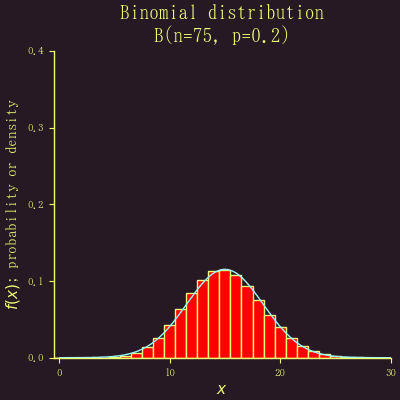ポアソン分布においては,ポアソン定数 λが大きくなるにつれ,正規分布に近づく。
ただし,二項分布が正規分布に近づくのに比べると,遅い。

最終時点での結果は以下の通り。正規分布曲線にはまだ十分近づいているとは言いがたい。

using Plots, PlotThemes, Rmathx
function poissondistribution(; fps=7)
maxx = 40
theme(:lime)
pyplot(grid=false, xlims=(-0.5, maxx), ylims=(0, 0.3),
label="", size=(400, 400))
x2 = 0:0.1:maxx
anim = @animate for λ = 1:0.5:floor(Int, maxx/2)
x = 0:maxx
y = dpois.(x, λ)
bar(x, y, bar_width=1, color=:red, tick_direction=:out,
xlabel="\$x\$", ylabel="\$f(x;λ)\$; probability or density")
y2 = dnorm.(x2, λ, sqrt(λ))
plot!(x2, y2, color=:cadetblue1,
title="poisson distribution\nPois(x;λ=$λ)")
end
savefig("last.png")
gif(anim, "poissondistribution.gif", fps=fps)
end
d = poissondistribution()






















